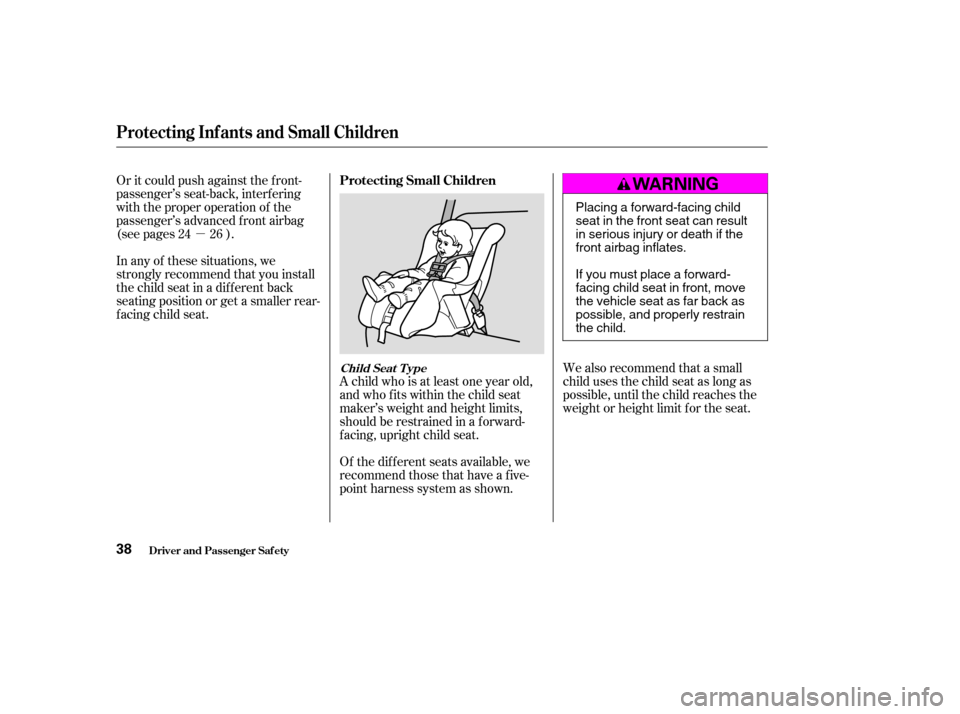Page 27 of 313

If the indicator comes on at any
other time, or does not come on at all,
you should have the system checked
by your dealer. For example:If the SRS indicator does not come
on after you turn the ignition
switch to ON (II).
If the indicator stays on after the
engine starts.
If the indicator comes on or
flashesonandoff whileyoudrive. If you see any of these indications,
the airbags and the seat belt
tensioners may not work properly
when you need them.
This indicator alerts you
that the passenger’s side
airbag has been automatically shut
of f . It does mean there is a
problem with your side airbags.
To reduce the risk of injury f rom an
inf lating side airbag, your vehicle has
an automatic cutoff system for the
passenger’s side airbag.
Although Honda does not encourage
children to ride in f ront, this system
is designed to shut of f the side
airbag if a child leans sideways and
the child’s head is in the side airbag
deployment path.
Only on models equipped with side
airbags
Additional Inf ormation About Your Airbags
Driver and Passenger Saf ety
How the Side Airbag Of f
Indicator Works
not
28
Ignoring the SRS indicator can
result in serious injury or death
if the airbag systems or
tensioners do not work properly.
Have your vehicle checked by a
dealer as soon as possible if
the SRS indicator alerts you to
a possible problem.
�����—�����—�����y�
�������������y���
�(���%���
���y�������
�y
Page 31 of 313

�µ
�µ�µ
Each year, many children are injured
or killed in vehicle crashes because
they are either unrestrained or not
properly restrained. In f act, vehicle
accidents are the number one cause
of death of children ages 12 and
under.
To reduce the number of child
deaths and injuries, every state and
Canadian province requires that
inf ants and children be properly
restrained when they ride in a
vehicle.
(see pages ).(see pages ).
If you have children, or if you ever
need to drive with a child in your
vehicle, be sure to read this section.
It begins with important general
guidelines, then presents special
inf ormation f or inf ants, small
children, and larger children.
Children depend on adults to protect
them. However, despite their best
intentions, many adults do not know
how to properly protect child
passengers.
39 46
47 50
Protecting Children General Guidelines
Driver and Passenger Saf ety
All Children Must Be Restrained
Inf ant s and small children must berest rained in an approved child seatt hat is properly secured t o t hevehicle
Larger children must be restrainedwit h a lap/shoulder belt and ride ona boost er unt il t he seat belt f it s t hemproperly
32
Children who are unrestrained
or improperly restrained can be
seriously injured or killed in acrash.
Any child too small for a seat
belt should be properly
restrained in a child seat. A
larger child should be properly
restrained with a seat belt and
use a booster if necessary.
�����—�����—�����y�
�������������y���
�(���%���
���y���������y
Page 32 of 313

�µ
�µ
According to accident statistics,
children of all ages and sizes are
saf er when they are restrained in the
back seat. The National Highway
Traffic Safety Administration and
Transport Canada recommend that
all children age 12 and under be
properly restrained in the back seat.
Children who ride in back are less
likely to be injured by striking
interior vehicle parts during a
collision or hard braking. Also,
children cannot be injured by an
inf lating airbag when they ride in the
back. Front airbags have been designed to
help protect adults in a moderate to
severe f rontal collision. To do this
the passenger’s f ront airbag is quite
large and it can inf late with enough
f orce to cause very serious injuries.
To help prevent airbag-caused
injuries to children, this vehicle has
an advanced airbag system.
With this system, the front
passenger’s airbag is turned of f if
sensors detect a total weight of less
thanabout65lbs(30kg)ontheseat
(see pages f or additional
inf ormation about how the f ront
passenger’s advanced airbag works).
Even if the passenger’s f ront airbag
is turned of f , we strongly
recommend that children age 12 and
under ride properly restrained in a
back seat where they will be saf er.
24 26
CONT INUED
Protecting Children General Guidelines
Driver and Passenger Saf ety
All Children Should Sit in the
Back Seat
The Passenger’s Front Airbag
Can Pose Serious Risks
33
�����—�����—�����y�
���������
�
�y���
�(���%���
���y���������y
Page 33 of 313
�µ
To remind you of the passenger’s
f ront airbag hazards, and that
children must be properly restrained
in the back seat, your vehicle has
warninglabelsonthedashboardand
on the driver’s and f ront passenger’s
visors. Please read and f ollow the
instructions on these labels.To remind you of the f ront airbag
hazards, your vehicle has warning
labels on the driver’s and f ront
passenger’s visors. Please read and
f ollow the instructions on these
labels.
Protecting Children General Guidelines
Driver and Passenger Saf ety
U.S. Models Canadian Models
34
�����—�����—�����y�
�������������y���
�(���%���
���y���������y
Page 34 of 313

�µ
Your vehicle has three seating
positions in the back seat where
children can be properly restrained.
If you ever have to carry four
children in your vehicle, and a child
must ride in f ront:Move the vehicle seat as far to the
rear as possible (see page ).
Place the largest child in the f ront
seat, provided the child is large
enough to wear the lap/shoulder
belt properly (see page ).
Have the child sit upright and well
backintheseat(seepage ).
Make sure the seat belt is properly
positioned and secured (see page
). Many parents say they pref er to put
an inf ant or small child in the f ront
passenger seat so they can watch the
child, or because the child requires
attention.
Placing a child in the f ront seat
exposes the child to hazards in a
f rontal collision, and paying close
attention to a child distracts the
driver from the important tasks of
driving, placing both of you at risk.
If a child requires close physical
attention or f requent visual
contact, we strongly recommend
that another adult ride with the
child in the back seat. The back
seat is far safer for a child than the
front.
15 11
47
14
Protecting Children General Guidelines
Driver and Passenger Saf ety
If a Child Requires Close
Attention
If You Must Drive with Several
Children
35
�����—�����—�����y�
�������������y���
�(���%���
���y���������y
Page 35 of 313

�µ
Never put a seat belt over yourself
and a child. During a crash, the
belt could press deep into the child
and cause serious or fatal injuries.
Never let two children use the
same seat belt. If they do, they
could be very seriously injured in a
crash.Do not leave children alone in a
vehicle. Leaving children without
adult supervision is illegal in most
states and Canadian provinces,
and can be very hazardous.
For example, infants and small
childrenleftinavehicleonahot
day can die f rom heatstroke. A
child lef t alone with the key in the
ignition can accidentally set the
vehicle in motion, possibly injuring
themselves or others.
Lock both doors and the trunk
when your vehicle is not in use.
Children who play in vehicles can
accidentally get trapped inside the
trunk and be seriously injured or
could die. Teach your children not
to play in or around vehicles.
Know how to operate the
emergency trunk opener and
decide if your children should be
shown how to use this f eature (see
page ).Keep vehicle keys/remote
transmitters out of the reach of
children. Even very young
children learn how to unlock
vehicle doors, turn on the ignition,
and open the trunk, which can
lead to accidental injury or death.
Neverholdaninfantorchildon
your lap. If you are not wearing a
seat belt in crash, you could be
thrown f orward and crush the
child against the dashboard or a
seat-back. If you are wearing a
seat belt, the child can be torn
from your arms and be seriously
hurt or killed.
82
Additional Saf ety Precautions
Protecting Children General Guidelines
Driver and Passenger Saf ety36
�����—�����—�����y�
�������������y���
�(���%���
���y���������y
Page 36 of 313

Only a rear-f acing child seat provides
proper support f or a baby’s head,
neck, and back.Two types of seats may be used: a
seat designed exclusively f or inf ants,
or a convertible seat used in the rear-
f acing, reclining mode.
An inf ant must be properly
restrained in a rear-f acing, reclining
child seat until the child reaches the
seat maker’s weight or height limit
f or the seat, and the child is at least
one year old. If placed
f acing f orward, an inf ant could be
very seriously injured during a
f rontal collision. A rear-f acing child seat should
always be installed in a back seat, not
in the f ront. Even with adbanced
airbags, which can automatically
turn the passenger’s f ront airbag of f
(see page ), a back seat is the
saf est place f or an inf ant.
When properly installed, a rear-
f acing child seat may prevent the
driver or a f ront passenger f rom
moving the seat as far back as
recommended, or f rom locking the
seat-back in the desired position.
24
CONT INUED
Protecting Inf ants and Small Children
Driver and Passenger Saf ety
Protecting Inf ants
Child Seat T ype
Do not put a rear-f acing child seat ina f orward-f acing position. Child Seat Placement
37
Placing a rear-facing child seat
in the front seat can result in
serious injury or death during acollision.
Always place a rear-facing child
seat in the back seat, not thefront.
�����—�����—�����y�
�������������y���
�(���%���
���y���������y
Page 37 of 313

�µWe also recommend that a small
child uses the child seat as long as
possible, until the child reaches the
weight or height limit f or the seat.
A child who is at least one year old,
and who fits within the child seat
maker’s weight and height limits,
should be restrained in a f orward-
f acing, upright child seat.
Of the different seats available, we
recommend those that have a f ive-
point harness system as shown.
Or it could push against the f ront-
passenger’s seat-back, interf ering
with the proper operation of the
passenger’s advanced front airbag
(see pages ).
In any of these situations, we
strongly recommend that you install
the child seat in a dif f erent back
seating position or get a smaller rear-
f acing child seat.
24 26
Protecting Inf ants and Small Children
Driver and Passenger Saf ety
Protecting Small Children
Child Seat T ype
38
Placing a forward-facing child
seat in the front seat can result
in serious injury or death if the
front airbag inflates.
Ifyoumustplaceaforward-
facing child seat in front, move
the vehicle seat as far back as
possible, and properly restrain
the child.
�����—�����—�����y�
�������������y���
�(���%���
���y�������
�y